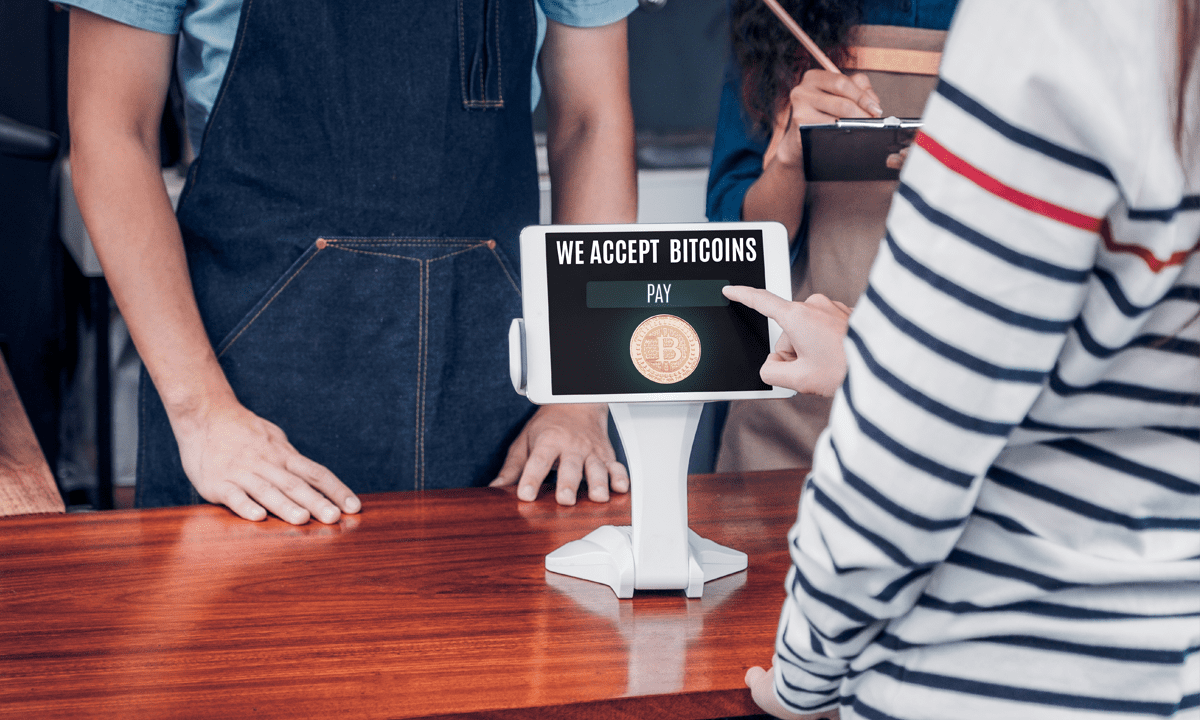The New Math of Crypto Payments

There’s a fundamental difference between paying with crypto and paying in crypto that will play a big role in whether the broader public comes to use bitcoin, ether and the like at the till and the checkout screen.
At present, by and large, people are paying with crypto but thinking in dollars — for example using a crypto debit card at the point of sale. This works fine if you’re a crypto investor who wants to be able to use it without having to go through the hassle of going to an exchange and off-ramping some of your bitcoin holdings into cash.
Not-So-Foreign Exchange
That’s not a big deal when you are buying a couch or a car, but it’s unreasonably inconvenient for a cup of coffee or dinner at a restaurant. And it essentially assumes that most or at least a significant portion of your disposable income is kept in crypto. Which in turn assumes that you are a serious crypto investor who thinks that your bitcoin, ether, dogecoin, XRP or whatever will increase in value so much over the long term that you want to keep all or at least a large portion of your wealth in crypto.
Or that your salary comes in crypto — which is something that several companies, like the exchange Coinbase, are trying to make easier on employers.
But paying with crypto isn’t really a revolution, it’s more like a debit card drawing on a money market account. And it isn’t really convenient, especially with cryptocurrencies regularly fluctuating 5% or 10% or more on a daily to weekly basis — and rising or falling 50% or more over several months.
A good way to think of it is to consider paying for things as a tourist in a foreign country. Not in the Eurozone, where 1 euro is at present $1.01, but somewhere where 27, 3,872 or 680,000 of the local currency is equal to $1. When you’re in that situation you generally spend several days doing FX conversions in your head or asking Siri every time you buy something. Eventually you get the hang of it, but crypto’s fluctuations can make it more like a tour group seeing a new country every few days.
Paying in Crypto?
Is it worth going through the process of accepting crypto as a merchant? Sure. A growing number of people want that ability and will seek out merchants who provide it.
See also: PYMNTS Data Show Crypto’s Use for in-Store Purchases Is Growing
According to PYMNTS’ study The U.S. Crypto Consumer, Cryptocurrency Use In Online and In-Store Purchases, 27% of crypto-owning consumers say they “probably” or “definitely” prefer shopping at merchants who accept crypto.
But for crypto to do what Bitcoin creator Satoshi Nakamoto wanted — to make cryptocurrencies a replacement for national currencies on a day-to day basis — that is a long way off.
Thinking in Crypto
For people to pay in cryptocurrency means, essentially, thinking in it.
“There’s a cognitive shift that has to happen,” Kevin Beauregard, CEO of blockchain game studio Atmos Labs, told PYMNTS recently. “People have to think in a different currency. Most people in the real world think, ‘I work for a job, my salary is paid in dollars, and I expect to accumulate more dollars over time.’”
That’s changed in one place, he believes: Nonfungible tokens (NFTs).
The original NFT marketplaces all priced and sold NFTs in ether — ETH — and early collectors, who tend to be hardcore crypto users, now think in ETH, Beauregard said
“They’re fundamentally going, ‘I acquired this NFT for this much ETH and I can sell it for how much ETH,’ ” he said. “They actually think in ETH now.”
That’s something that, he said, he would never have believed possible five years ago.
However, his point was that dollar-pegged stablecoins remove the need for that cognitive shift. “Getting to a fundamental unit of account that people understand is an important thing,” he added.
That was one of the big reasons that central bankers, treasury departments and international financial institutions blew up so hard and then-Facebook’s Libra project — it was a stablecoin pegged to a basket of currencies but not any single one, like the dollar. By allowing 2.3 billion users to instantly think in and pay with libras, the project would get them to stop thinking in their own currencies, diminishing its control and authority. It’s why many countries with weak currencies aren’t happy when people “dollarize” purchases.
While stablecoin opponents fear that privately controlled cryptocurrencies will damage central banks’ ability to influence the economy, removing the national currency as a denominator or goods takes that a step further.
But it’s a very big step.
And paying with a dollar-pegged stablecoin (in the U.S.) provides some conveniences on the back-end, like instant settlement and cross-border payments, but as many stablecoin opponents have pointed out recently, FedNow and The Clearing House have that first part covered, or will soon, and cross-border payments isn’t a day-to-day need for most individual consumers.
The utility of stablecoins — outside the crypto trading and DeFi worlds — at this point is largely to make it easier for crypto owners to make payments than by deciding if they want to spend 0.00045 BTC.
